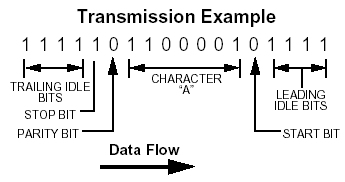Information being transferred
between data processing equipment
and peripherals is in the form of
digital data which is transmitted in
either a serial or parallel mode.
Parallel communications are used
mainly for connections between test
instruments or computers and
printers, while serial is often used
between computers and other
peripherals.
Serial transmission involves the
sending of data one bit at a time,
over a single communications line.
In contrast, parallel communications
require at least as many lines as
there are bits in a word being
transmitted (for an 8-bit word, a
minimum of 8 lines are needed).
Serial transmission is beneficial for
long distance communications,
whereas parallel is designed for
short distances or when very high
transmission rates are required.
Standards
One of the advantages of a serial
system is that it lends itself to
transmission over telephone lines.
The serial digital data can be
converted by modem, placed onto a
standard voice-grade telephone
line, and converted back to serial
digital data at the receiving end of
the line by another modem.
Officially, RS-232 is defined as the
“Interface between data terminal
equipment and data
communications equipment using
serial binary data exchange.” This
definition defines data terminal
equipment (DTE) as the computer,
while data communications
equipment (DCE) is the modem. A
modem cable has pin-to-pin
connections, and is designed to
connect a DTE device to a DCE
device.
Interfaces
In addition to communications
between computer equipment over
telephone lines, RS-232 is now
widely used for connections
between data acquisition devices
and computer systems. As in the
definition of RS232, the computer is
data transmission equipment (DTE).
However, many interface products
are not data communications
equipment (DCE). Null modem
cables are designed for this
situation; rather than having the pinto-
pin connections of modem
cables, null modem cables have
different internal wiring to allow DTE
devices to communicate with one
another.
Cabling Options
RS-232 cables are commonly
available with either 4, 9 or 25-pin
wiring. The 25-pin cable connects
every pin; the 9-pin cables do not
include many of the uncommonly
used connections; 4-pin cables
provide the bare minimum
connections, and have jumpers to
provide “handshaking” for those
devices that require it. These
jumpers connect pins 4, 5 and 8,
and also pins 6 and 20.
The advent of the IBM PC AT has
created a new wrinkle in RS-232
communications. Rather than
having the standard 25-pin
connector, this computer and many
new expansion boards for pc’s
feature a 9-pin serial port. To
connect this port to a standard 25-
pin port, a 9- to 25-pin adaptor cable
may be utilized, or the user may
create his own cable specifically for
that purpose.
Selecting a Cable
The major considerations in
choosing an RS-232 cable are
based upon the devices to be
connected. First, are you connecting
two DTE devices (null modem
cable) or a DTE device to a DCE
device (modem cable)? Second,
what connectors are required on
each end, male or female, and 25 or
9-pin (AT style)? Usually, it is
recommended that the user obtain
the two devices to be connected,
and then determine which cable is
required.
RS-232 Specifications
 TRANSMITTED SIGNAL
TRANSMITTED SIGNAL
VOLTAGE LEVELS:
Binary 0: +5 to +15 Vdc (called a “ space” or “on”)
Binary 1: -5 to -15 Vdc (called a “mark” or “off”)
RECEIVED SIGNAL
VOLTAGE LEVELS:
Binary 0: +3 to +13 Vdc
Binary 1: -3 to -13 Vdc
DATA FORMAT
Start bit: Binary 0
Data: 5, 6, 7 or 8 bits
Parity: Odd, even, mark or space (not used with 8-bit data)
Stop bit: Binary 1, one or two bits

|









